The “Irwin” in Irwin Yachts is Ted Irwin, a boat designer and builder who has been around nearly as long as production fiberglass boats have.

Over the years, Ted Irwin has designed, and Irwin Yachts has built, a variety of sailing boats—from flatout cruising condos to full-bore racing machines. Starting with the combination racer/cruisers that were then fashionable, Irwin began producing in the 1970s not only cruiser/racers like the Irwin 28, 30, and 37 one-ton, but also roomy center cockpit cruisers like the 37, 38 and 43.
The company has been consistent in the niche they occupy in the sailboat market. Their line has been known as middle of the spectrum, better in quality than the cheapest boats on the market, yet with low enough prices to make the economy shopper think twice before jumping for the cheaper alternatives.
In style, the Citations continue the moderate tradition of Irwin designs. The Citation models are all similar, fairly high-sided with very short overhangs and a low cabin top. The distinctive profile is usually accentuated by a dark sheer stripe that makes a sharp downturn to follow the reverse transom.
In all modern boats with flat bottoms, it’s hard getting good headroom without making the boat look ugly. The choice is to keep the sheer line low and attractive and use a high cabin house, or use high sheer and a low cabin top. The Citations use the second method and depend on the sheer stripe to keep the high freeboard from looking ugly. The sculpted cabin top keeps the entire profile low, with a high coaming flowing from the back edge of the cabin to the back of the cockpit.
A distinctive characteristic of the Citations is a complex swim ladder at the aft end of the cockpit. The ladder is molded into a section of the transom which opens up and swings down for boarding. With the rear end of the cockpit open, it is an effective ladder, but owners report that it is somewhat awkward and difficult to prepare for use. The owner of the boat we sailed described the deployment of the ladder as a “nuisance.”
As the largest of the Citations, the 38 is probably the best looking, handling the high-sidedness better than her smaller sisters. The boat has three windows set in the sheer stripe on each side, so they are not very noticeable. Like the other Citations it is distinctly modern-looking—not pretty, but not ugly either.
The company touts the 38 and the two smaller Citations as developments of Irwin’s custom racer, Razzle Dazzle, which performed very well on the Southern Ocean Racing Circuit. But they seem to us at best distant cousins of that flashy racer.
Though Irwin has never gone for super-lightweight boats, the production Citations are so much heavier that the comparison seems to be primarily a marketing ploy.
Hull And Deck
In general, Irwin uses conventional modern techniques in building the fiberglass hull and deck. The hull is a one-piece hand-laminated molding, using 24-ounce roving and biaxial fiberglass. Forward of the mast, the hull molding has a foam core—a design feature to provide stiffness and save weight. In today’s market, such cored construction is economically feasible if you want a stiff hull and can charge a price above the bottom of the market.
The hull is further stiffened and strengthened by the interior fiberglass grid which incorporates fiberglass stringers to support the keel, mast, and major components of the cabin interior.
The deck is also a one-piece molding, with foam core in the cabin top and walkways, plywood core underneath the winches and hardware. Hull and deck are bolted together through an aluminum toerail.
Standard keel on the 38 is a lead wing design drawing 4′ 11″. A conventional lead fin is available as an option, and the boat we sailed had the conventional fin. Both keels are external, bolted through the hull and the interior grid.
The shoal draft of the wing, saving 2′ compared to the fin, is an obvious advantage. We generally remain skeptical of the value of the wing keel, having seen some very poorly performing ones which were about as effective going to windward as a flopperstopper.
But Irwin apparently has enough faith in their design to make it standard. If we were never going to race the boat, we’d consider trying a wing, but otherwise we’d probably opt for the fin and pay the draft penalty.
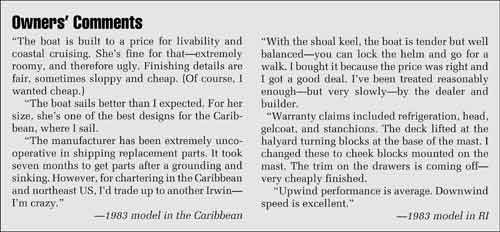
The rudder is a conventional modern high-aspect spade driven by a 36″ wheel on a pedestal.
Exterior finish of the boat is generally good. The gelcoat does not have a high-gloss finish, but rather more of a matte appearance. This should be easier to maintain, making nicks and scratches less noticeable. The hull molding is fair, with no evident hard spots or ridges, and the deck molding is well done. The non-skid pattern is adequate, but minimal; it should be easy on bare feet.
There is hardly any exterior wood to care for—four teak grab rails and two plywood companionway hatch boards. The hatch boards on our test boat were poorly finished. A meticulous owner will want to finish them properly, or perhaps replace them with some higher-quality plywood, teak or plastic.
Rig
The rig is made in-house by Irwin and would generally be considered overbuilt by modern standards. The mast has two sets of spreaders and is stepped on the keel. The backstay is split to accommodate the fold-out boarding ladder in the transom, and the boat we sailed had single lower shrouds with a babystay forward. Halyards and other running rigging are internal.
Although the top quarter of the mast is tapered, the extrusion is so heavy that we had trouble bending it with the backstay adjuster. The adjustable babystay was also arranged in such a way that there was minimal pull forward, but we re-rigged it and were finally able to get enough mast bend to flatten the mainsail in heavy winds. It is not clear to us why Irwin uses an adjustable babystay rather than forward lower shrouds, especially when the mast is so stiff. Cruisers would more likely prefer the more conventional rig with double lowers, which would be somewhat stronger.
The boom and fittings are good quality, with jiffy-reefing lines and topping lift led internally from the outboard end to exit at the mast.
Halyards and all other running rigging are Dacron. Standing rigging is conventional stainless steel wire with swaged fittings, plenty heavy, but lighter than you might expect with the super-heavy mast. Shroud chainplates are set well inboard, with stainless tierods belowdecks leading to anchor points on the hull grid.
Handling Under Sail
We raced four triangle races on the Citation 38 to judge her sailing ability. In general, she proved to have good sailing characteristics, well behaved with no obvious flaws or other problems.
Irwin advertises her PHRF (Performance Handicap Racing Fleet) rating as 130 with the wing keel, 120 with the fin keel—roughly about the same speed as a C&C 35 or many of the 1970s one-ton racer/cruisers like the Irwin 37 and Morgan 36. However, the local handicap of the boat we sailed is 108, a rating she could sail to only in light air off the wind.
In light winds the boat sails exceptionally well. In heavy winds, she certainly sails well enough to satisfy any serious sailor other than the dedicated racer, but she will not sail up to her rating relative to other modern lighter boats. She is generally fast enough to make good, satisfying passages for the cruising sailor. But we would generally not recommend her to the serious racer since the boat sails to her rating only in one condition, and it will be a struggle to win with the boat in heavy winds. For the very occasional racer who cruises most of the time, she should be satisfactory.
Specifically, the boat is exceptionally close-winded in light air, and ran very well in all winds.
Reaching, she is sometimes a handful in a breeze, but overall she is a good sailer, typical of the best modern production boat designs.
We were surprised at the apparent thoughtlessness in many details of the rigging. While the hardware and fittings such as blocks, winches and shackles were all top quality, the way things were set up made for all sorts of problems.
For instance, the backstay adjuster was arranged with what looked like a clever idea. The split backstay was equipped with a typical double-ended block and tackle arrangement. To cleat the line, a tunnel was cut through the coaming so the line could be led to a cam cleat inside the cockpit. Unfortunately, given the anchor points for the tackle, the line bound on itself and on the block, creating so much friction that the tackle was almost impossible to use—we resorted to one person hanging on the line while a second took the slack through the cam cleat.
Similarly, the mainsheet traveler is well forward—a good place to keep it out of the way of people, but a poor place for getting good leverage on the boom. Unfortunately, the traveler hardware was set up so that it was impossible for a single person to move the traveler car in heavy air. Two people were required: one to pull up the boom by hand and the other to pull in the traveler control lines. Before the third race we replaced the whole traveler with a multi-part Harken system that made it possible, if not easy, to control the traveler.

There are a number of other details in the rigging—such as the fact that none of the exits from the mast or boom are labeled in any way—that indicate corners cut in rigging the boat. Fortunately, all the problems are fairly easily corrected by an owner, but it is surprising to see a boat with good sailing potential handicapped by this rather sloppy attention to detail.
Handling Under Power
The boat is equipped with a 27 hp 3-cylinder Yanmar, which is adequate for the boat’s size and weight, although it is certainly not an excess of power. The boat backs well, turns sharply, and is easily driven to hull speed by the engine. The cruiser addicted to powering at a knot over hull speed may want to talk to Irwin about a larger engine, though one is not currently offered as an option. Irwin installs the same engine in the Citation 35, which seems like a better match. The tank on the 38 holds 30 gallons of diesel fuel—ample for good cruising range.
The engine is located in the center of the boat above the keel, underneath part of the settee and the galley cabinet. With an aft-cabin boat, this seems a sensible arrangement to us, giving good access to the engine while keeping the weight centered in the boat.
Like many builders, Irwin continues the practice of shipping the boat with a solid two-bladed prop, a crude way of keeping the price down. Anyone who is likely to order this type of well-performing sailboat will want to get a folding prop immediately. Most similar practices—such as offering the boat without lifelines as standard—have disappeared from the marketplace, but this peculiarity continues with almost all manufacturers.
On Decks
The low cabin house of the 38 makes the decks very usable, both for working the boat under sail and for lounging around. Furthest forward is an anchor roller beside the forestay, just ahead of an ordinary anchor locker to fit a Danforth-type anchor. The foredeck is wide and roomy enough to handle foresails. A big forward hatch in the low cabin top is usable for passing sails up and down.
The walkways are wide, with inboard shrouds, and the cockpit coaming is an easy step. Halyards and other control lines are led aft to the back of the cabin house where two Barient 17s are located. Small Dorade-type air inlets are molded into the cabin top just ahead of the traveler. The companionway hatch is off-center to port.
The cockpit is T-shaped, with comfortable benches and backrests. Barient 24 primaries are just adequate for the boat, but most owners will probably go for self-tailers all around.
There is a shallow cockpit locker on the port side, but the starboard locker is cavernous. We have yet to see a really good way of organizing these huge cockpit lockers, or of handling the oversize locker lid made up of the bench seat and part of the backrest.
The helmsman’s seat is peculiar in that it is removable as part of the process of folding out the transom ladder. Engine controls are on the steering pedestal.
Double lifelines, pulpit, and stern rail are standard.
Belowdecks
With a 12′ 6″ beam and a 30′ 8″ waterline, the interior of the Citation 38 is enormous, but it is broken up enough not to seem like a cavern. Forward is an ordinary V-berth that should be good for sleeping or sail storage. There’s a small bureau and hanging locker opposite, just aft of the berth.
In the main cabin, a U-shaped dinette is opposite a settee which can be used for a berth. The galley is roomy, open, and quite workable.
On the starboard side opposite the galley is a good navigator’s station with a swing-out chair and electrical panel above it. Just aft of the nav table is the head, with entrances from both the galley and the aft cabin.
The aft cabin is quite roomy, made possible mostly by the offset companionway hatch and forward engine location. The berth is huge and comfortable, and this cabin will undoubtedly be one of the selling points of the boat.
In general, interior equipment is of good quality, with propane stove, 90-gallon water tank, hot water heater, a dozen opening ports, and good lighting. Like most modern boats, the interior seems set up for weekending, with very little real storage space. A long-distance cruise will require converting some of the space for basic storage.
The only other shortcoming of the interior is that it looks like a standard, run-of-the-mill production boat, with lots of veneer and plastic, finished a little crudely in spots. But, for a relatively low-priced boat, it’s better to compromise here than in the hull construction or mechanical systems.
Conclusions
Overall, the Citation 38 is a good boat that seems a little ordinary, generally representative of mid-line production boats. Though such a statement may sound like faint praise, it really isn’t.
The boat is not as well finished as competitive boats like the Pearson 37, but it is generally better done than lower-priced boats such as the Hunter, and the price is appropriately in between.
Why would anyone choose this Irwin rather than one of her competitors? There are, of course, the personal considerations of appearance and aesthetics. Many people will consider the Citation 38 better looking than some of her boxier competitors.
To us, the main reason for choosing this boat would be the sailing performance. She has the feel of a well-designed boat, unlike so many other contemporary models which get their performance merely by combining big sail areas, long waterlines, and light weight. This boat sails very well.
The other consideration, of course, will be price. You can buy cheaper boats and you can easily buy more expensive boats. To us, Irwin has kept the price down in the most sensible way—not by compromising basic construction or eliminating layers of fiberglass, but by going to conventional components and easy construction in the interior.
For the avid racer, the Citation 38 is too much of a cruiser—something like the J/35 would be a better racing boat. And for the pure cruiser more interested in room than in sailing performance, a boat like the center cockpit Irwin 38 might be more suitable.
For a serious cruising sailor who likes a boat that sails well but still wants the size necessary for cruising in comfort, the Citation 38 would be a reasonable choice.





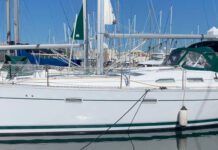







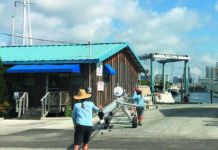



















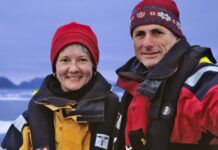




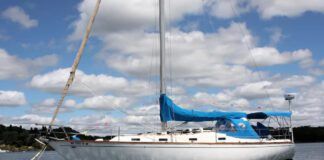
I like the article. An Irwin 38 in Redondo Beach is for sale and I wanted to research the boat a bit. Thanks
Is this boat a worthnes buying? How high is the head room in the cabin